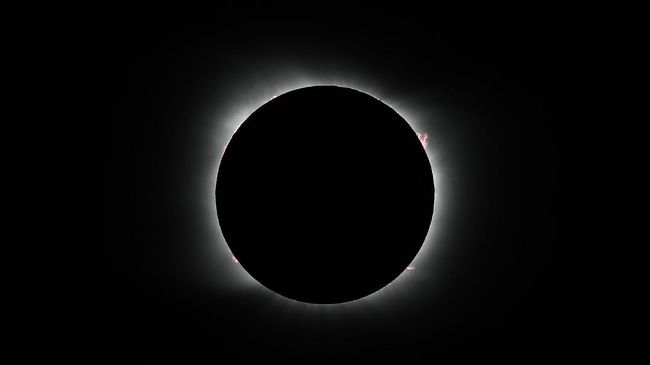Jakarta, CNN Indonesia —
In the first week of December 2021, a series of space phenomena occurred. Among them is the phenomenon of the solar eclipse on December 4 next.
A solar eclipse is a natural event that occurs when the Moon moves in its orbit, between the Earth and the Sun (known as an occultation). This eclipse occurs on the new Moon, when the Sun and Moon are in conjunction with each other.
The phenomenon of a solar eclipse depends on the geometry of the sun and moon, whether they are completely or only partially blocked.
During the eclipse phenomenon, the Moon’s shadow, which is divided into two parts, namely the dark umbra and dark penumbra, moves across the Earth’s surface.
1. Total Solar Eclipse in Antarctica December 4
Researcher at the Space Science Center of the National Institute of Aeronautics and Space (Lapan) of the National Research and Innovation Agency (BRIN) Andi Princeg said this phenomenon occurred in Antarctica on Saturday (4/12).
“The phenomenon of a solar eclipse has occurred since 07.03-08.04 Universal Time, in the Antarctic region affected by the Moon’s umbra. The region will experience a total solar eclipse with a total duration of between 90-116 seconds,” Andi said as quoted by the official website. Eight.
The width of the Moon’s umbra on the Earth’s surface varies between 421-450 kilometers.
Meanwhile, regions affected by the Moon’s penumbra, such as the Republic of South Africa, Namibia, southern Australia (Victoria, parts of New South Wales, the Australian Capital Territory and Tasmania, will experience a Partial Solar Eclipse with an eclipse width of less than 10 percent of the Sun’s diameter.
Meanwhile, the Malvinas Islands and Tierra del Fuego will experience a Partial Solar Eclipse with an eclipse width of between 10-40 percent of the diameter of the Sun.
South Georgia and the South Sandwich Islands experience a Partial Solar Eclipse with an eclipse width of between 93-97 percent of the Sun’s diameter.
This total solar eclipse is the 13th of 70 eclipses in the 152nd Saros Series. The total solar eclipse in Antarctica in the Saros 152 Series previously occurred on November 23, 2003 and will occur again on December 15, 2039 and December 26, 2057.
2. Venus-Saturn-Jupiter Triple Conjunction December 4th
In addition to the total solar eclipse phenomenon that will occur on December 4, 2021, there is a series of other celestial phenomena called Space Science Education, the National Research and Innovation Agency (BRIN) which will occur in the first week of December.
The Venus-Saturn-Jupiter Triple Conjunction phenomenon occurs in early December, greeted by three planets in triple conjunction in the evening sky, namely Venus, Saturn and Jupiter.
This phenomenon runs for four days from December 1 to 4, and can be seen from the beginning of twilight, which is 5 minutes after sunset for 2.5 hours from the southwest.
The planet Venus will set first before being followed by Saturn an hour later and Jupiter sets the most
The last one is at 23.00 local time.
The Venus-Saturn split angle varies between 18.4 degrees -16.4 degrees, while the Saturn-Jupiter split angle varies between 16.4 degrees-16.6 degrees.
Venus’s magnitude varies from -4.88 to -4.90 while Saturn’s magnitude is constant at +0.73. Meanwhile, Jupiter’s magnitude varies between -2.67 to -2.66. Venus is in the constellation Sagittarius while Saturn and Jupiter are both in the constellation Capricorn.
This phenomenon is quite rare, occurring on average once every 90 years. This phenomenon last occurred on July 31-August 23, 1922 and November 10-December 2, 1842.
This phenomenon will occur again on September 1-14 October 2101, 25-31 August 2180 and 27 April-4 May 2260.
Check out other celestial phenomena on the next page..
Early December Sky Phenomenon (Part 2)
–
– .


